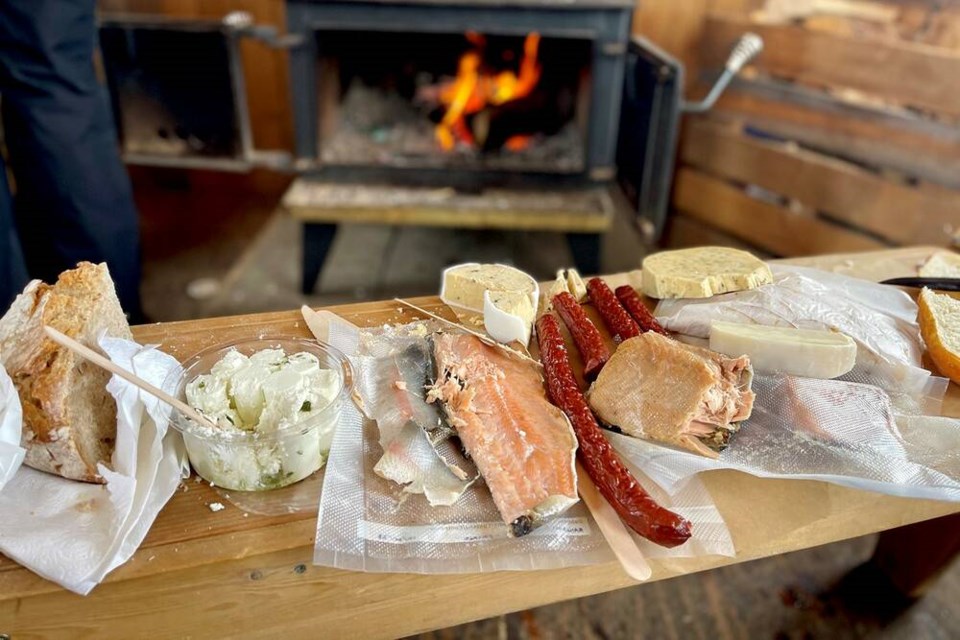For the whole of Christmas Eve day, our kitchen and patio served as a processing, brining, smoking and packing facility for rainbow trout caught in the fall by our son and his partner, fishing secret lakes in the North Okanagan.
Thankfully, components of our traditional meal had been prepared in advance, leaving time enough to switch camps on the fly, when our electronic Bradley Smart Smoker blew an in-line fuse just moments after lift-off.
Our son is nothing if not determined, so out came the pie tins, tin foil, blow torch and assorted hardwood chips. So began the hours and hours long process of low-fire grill-smoking fish the old fashioned way, in the dead of winter.
The trout were gorgeous. Some, speckled white on silver over salmon-coloured flesh, some speckled slate on charcoal over deep shades of melon – variations of the same species I was told, caught within days of each other, feasting on different insects in waters of varying cool and clear – all shot through nose-to-tail with bright pink.
A gifted white chinook joined the party too. We were on a roll, after all.
Paying tribute to the wild fish, we brined it first for four hours in a Salish Sea-salted water solution (72 grams each sea salt and brown sugar, dissolved in two litres water) infused with 12 fresh bay leaves from our garden, two heaping tablespoons finely ground home-grown thyme, and 72 grams of mixed black, pink, white and green peppercorns. The flavour was perfect: earthy and piney, like freshly dug forest floor.
After brining, the butterflied fish were rinsed and patted dry, and then left to develop a surface pellicle to help smoke penetrate the flesh. We were learning a few things about old-school smoking methods as we went, scrolling angler-chef-bloggers like Hank Shaw.
It was instinctive however, to reach for thyme, a wild perennial edible and natural preservative known for centuries for its powerful antiviral, antibacterial, antimicrobial, antifungal and antiseptic properties. A therapeutic salt and thyme bath would infuse the fish with optimal moisture, but also contribute fragrant antioxidant, anti-inflammatory and antineoplastic benefits as well.
The hardy “German thyme,” as my father called it, is my go-to variety. I prefer the woody stalks and thick, pine needle-like leaves of hardy thyme over all others, as it is easy to separate the leaves from the stalks in one swoop without breaking stems or picking leaves one at a time until my thumbs bleed.
Hardy thyme grows in a planter outside the kitchen door all year-round. I cut it back often, then dry the leaves and store them whole until needed. A few seconds in a dedicated spice grinder or mortar and pestle is all it takes to release thyme’s phytochemical goodness.
Family food stories tend to linger, and the fish smoking adventure was no exception. While the bulk of the vacuum packs were destined for the freezer, one sparkling rainbow – caught by my husband when we visited our son in September – plus a generous chunk of chinook, travelled 700 kilometres east with our family on Boxing Day, to Rossland and Red Mountain, in the beautiful Kootenay Sea.
We laughed, we skied, we played and we snowshoed. And, at 1,575 metres above sea level, in the diminutive “Eagles Nest” warming hut, we broke homemade bread and shared a fireside feast of artisanal cheeses and thyme-brine smoked fish with each other, and with new friends from all over the world.
Where we are together, sharing good food prepared simply, that is home. Happy new year.
Laura Marie Neubert is a West Vancouver-based urban permaculture designer. Follow her on Instagram @upfrontandbeautiful, learn more about permaculture by visiting her Upfront & Beautiful website or email your questions to her here.
For a taste of permaculture, watch the video below:




